 To enhance service speed and avoid tariff delays, we've opened a US warehouse. All US orders ship directly from our US facility.
To enhance service speed and avoid tariff delays, we've opened a US warehouse. All US orders ship directly from our US facility.
| Cat. No. | Product Name | Field of Application | Chemical Structure |
|---|---|---|---|
| DC67522 | AZD Lipid 17 Featured |
Lipid 17 is a novel, highly potent ionizable lipid designed for mRNA delivery within lipid nanoparticles (LNPs) developed by AstraZeneca . Its structure features a secondary amine head group attached to a cyclic ether moiety (specifically, the 2-oxaspiro[3.3]heptan-6-amine head group). It possesses an asymmetric tail architecture: one tail is derived from heptadecan-9-ol (a branched C17 secondary alcohol), while the other tail is a modified nonyl chain (C9) with a key ethyl branch at the 3-position. The linker connecting the head group to the tails has a length equivalent to n=3 (three methylene units) as defined in the study. This specific combination of the secondary amine cyclic ether head group, asymmetric tails, and the ethyl branch at the 3-position of the nonyl chain proved critical for its exceptional performance. When formulated into LNPs and administered intravenously in mice, Lipid 17 demonstrated a remarkable 6-fold increase in functional protein (eGFP) expression in the liver compared to the benchmark lipid MC3, with high statistical significance (P < 0.0001). This makes Lipid 17 one of the most active lipids identified in the study and a promising candidate for liver-targeted mRNA therapeutics.
More description
|

|
| DC67524 | Nitto Lipid 19 Featured |
Lipid 19 is an engineered cationic lipid designed to optimize the delivery of RNA within lipid nanoparticles (LNPs) developed by Nitto. Its unique structure—featuring a dual-hydroxyl headgroup and tailored hydrophobic chains—enables highly efficient encapsulation of these fragile genetic payloads, protecting them from degradation. The resulting LNPs exhibit exceptional stability (<100 nm size), target the liver specifically for enhanced therapeutic impact, and support applications ranging from mRNA vaccines to gene-silencing therapies. This makes lipid 19 a pivotal advancement in precision nanomedicine for liver-related disorders.
More description
|

|
| DC60545 | 200Oi10 Featured |
200Oi10 is an ionizable lipidoid used in lipid nanoparticles (LNPs) for RNA delivery. Structurally, it features ester-conjugated cleavable lipid tails, enhancing biodegradability and reducing toxicity compared to non-cleavable analogs. Preclinical studies show that 200Oi10-based LNPs primarily accumulate in the liver (97.7%) after intravenous administration. However, intraperitoneal injection redirects biodistribution, achieving 46.4% pancreatic uptake, which can be further amplified by incorporating cationic lipids like DOTAP. This unique tropism enables pancreas-targeted mRNA delivery. 200Oi10's ester linkages promote rapid clearance, improving biocompatibility while maintaining siRNA/mRNA delivery efficiency. Its design exemplifies the use of degradable lipidoids to balance organ specificity, efficacy, and safety in RNA therapeutics.
More description
|

|
| DC60800 | 18-2-9b2 Featured |
18-2-9b2 is a dendron-like degradable ionizable lipid which facilitates mRNA delivery to splenic macrophages. 18-2-9b2 LNP encapsulating therapeutic BTB domain and CNC homologue 1 (BACH1) mRNA exhibited proficient BACH1 expression and subsequent Spic downregulation in splenic red pulp macrophages (RPM) in a Spic-GFP transgene model.
More description
|
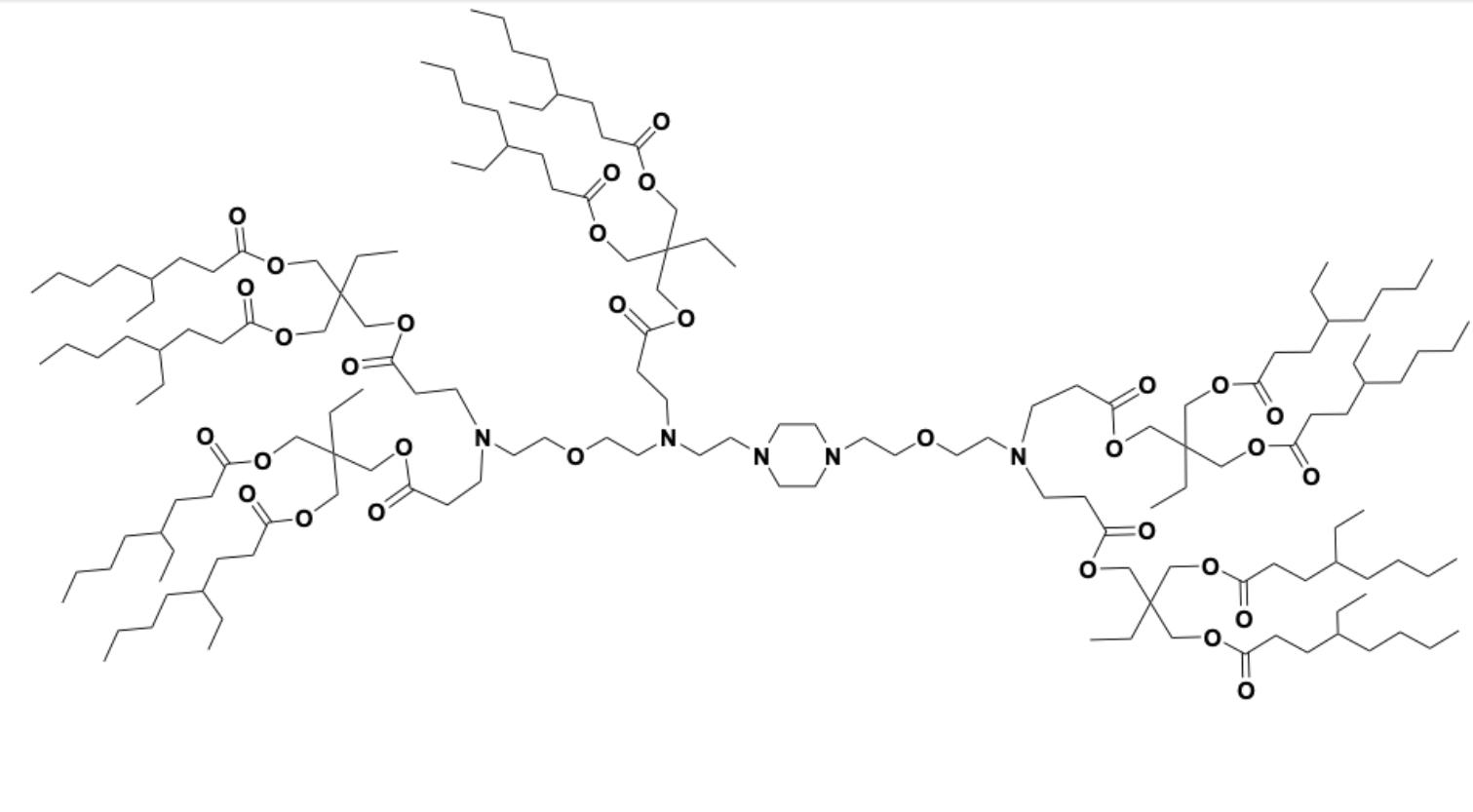
|
| DC60842 | Lipid H7T4-4 Featured |
H7T4-4 is an ionizable lipid designed for mRNA delivery via lipid nanoparticles (LNPs). It features a cyclic amine headgroup (derived from cyclen tetrahydrochloride) and four C14 hydrophobic alkyl tails, synthesized through a Michael addition reaction between cyclen and 1,2-epoxytetradecane. With a high transition temperature (Tm = 58.6°C) due to strong intermolecular interactions from its cyclic headgroup and multi-tail structure, H7T4-4 alone forms rigid aggregates incompatible with mRNA encapsulation. However, when blended with low-Tm helper lipids (e.g., DOPE, Tm = -16°C), the system’s overall Tm decreases, enabling stable LNP formation. Optimized formulations (20% H7T4-4, 41% DOPE, 38% cholesterol, 1% DMG-PEG) exhibit efficient mRNA encapsulation (>90%) and transfection. Structural analyses (SAXS, cryo-TEM) confirm monodisperse LNPs with lamellar/hexagonal phases. In vivo, H7T4-4 LNPs show tumor-targeted and intranasal mRNA delivery with reduced off-target accumulation compared to SM-102-based LNPs. This rational design highlights Tm-guided helper lipid selection to overcome rigidity challenges in ionizable lipids.
More description
|
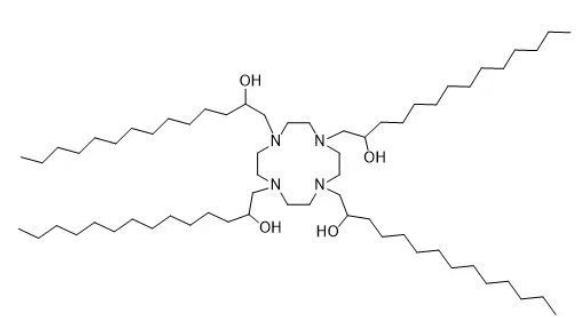
|
| DC60843 | CF3-2N6-UC18 Featured |
CF3-2N6-UC18 is a rationally designed chloroquine-inspired ionizable lipid that enables robust mRNA delivery and genome editing. It integrates three modular components: a 7-trifluoromethyl-substituted quinoline scaffold (mimicking chloroquine’s endosomolytic properties), a hexamethylenediamine linker with two ionizable nitrogen atoms (pH-responsive protonation), and two unsaturated oleyl (C18:1) hydrophobic tails (enhancing membrane fusion and nanoparticle stability). This lipid self-assembles into ecoLNPs (endosomolytic chloroquine-like lipid nanoparticles) with spherical morphology (~200 nm diameter, 98% mRNA encapsulation). Its pH-sensitive activity triggers endosomal escape through dual mechanisms: proton sponge effect (buffering endo-lysosomal pH) and saposin B-mediated membrane disruption (molecular docking confirms chloroquine-like binding to lysosomal saposin B). In vitro, ecoLNPs outperform commercial reagents (18.9-fold higher mRNA delivery than Lipofectamine 2000) and penetrate 3D cell models. They resist serum/RNase degradation and retain >90% activity after 7-day storage at 4°C. In vivo, ecoLNPs achieve tissue-specific mRNA expression via multiple routes (intravenous, intramuscular, etc.), with strong lymph node tropism (90.2% after intramuscular injection) comparable to SM-102 LNPs (Moderna’s COVID-19 vaccine carrier). They mediate efficient Cre mRNA-driven recombination and CRISPR-Cas9 editing in transgenic mice. CF3-2N6-UC18’s modular design, stability, and dual endosomal escape strategies position it as a versatile platform for mRNA vaccines, gene therapy, and genome editing applications.
More description
|

|
| DC60579 | Lipid B3 Featured |
Lipid B3 is a biodegradable ionizable lipid for liver targeted delivery. Lipid B3-LNP shows high delivery efficacy and low toxicity in delivering RNA to liver cells.
More description
|
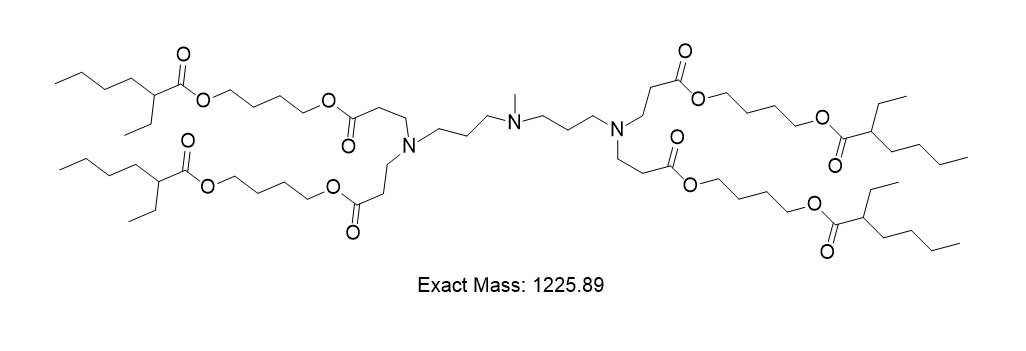
|
| DC85555 | 2-Octyldecyl 6-[[4-(decyloxy)-4-oxobutyl](2- hydroxyethyl)amino]hexanoate Featured |
YK-009 is a novel ionizable lipid for mRNA delivery. Comparisons of YK009-LNP-mRNA and commercial MC3-LNP-mRNA showed that YK009-LNP-mRNA vaccines had good biodistribution patterns, favorable tissue clearance, and high delivery efficiency. Furthermore, our study proved that YK009-LNP-Omicron mRNA could trigger a robust immune response and immune protection against the SARS-CoV-2 Omicron variant.
More description
|

|
| DC67531 | ATX-129(ATX-0129,10q) |
ATX-129 is a novel ionizable lipid used in the formulation of lipid nanoparticles (LNPs) for the delivery of RNA developed by Arcturus.
More description
|

|
| DC67532 | ATX-111 |
ATX-111 is a novel ionizable lipid used in the formulation of lipid nanoparticles (LNPs) for the delivery of RNA developed by Arcturus.
More description
|

|
| DC67533 | ATX-132 |
ATX-132 is a novel ionizable lipid used in the formulation of lipid nanoparticles (LNPs) for the delivery of RNA developed by Arcturus.
More description
|

|
| DC67534 | ATX-100 |
ATX-100 is a novel ionizable lipid used in the formulation of lipid nanoparticles (LNPs) for the delivery of RNA developed by Arcturus.
More description
|

|
| DC67535 | ATX-106 |
ATX-106 is a novel ionizable lipid used in the formulation of lipid nanoparticles (LNPs) for the delivery of RNA developed by Arcturus.
More description
|

|
| DC67530 | HY-501 Featured |
HY-501 is a next-generation cationically ionizable lipid engineered for high-efficiency RNA delivery developed by Biontech. Formulated at 40–50 mol% in lipid nanoparticles (LNPs) alongside DSPC, cholesterol, and polysarcosine-conjugated lipid C14pSar23, HY-501 yields uniform, stable particles (80–100 nm) with >90% RNA encapsulation. It demonstrates superior in vivo performance: driving 2-fold higher protein expression than benchmark lipids (EA-405/HY-405) in muscle tissue, minimizing off-target liver accumulation, and reducing immunogenic risks (near-zero complement activation and <5% hemolysis). Preclinically, HY-501-based LNPs encoding SARS-CoV-2 spike protein elicit potent neutralizing antibodies and T-cell responses, underscoring its utility in precision vaccines. Its combination of scalable synthesis, exceptional transfection efficiency, and biosafety establishes HY-501 as a transformative vector for therapeutic RNA delivery.
More description
|

|
| DC67539 | Lipid CS22021 |
CS22021 is a novel, synthetically engineered ionizable sterol lipid (ISL) developed by CanSino, specifically designed for advanced mRNA delivery via lipid nanoparticles (LNPs). Its core innovation lies in its unique molecular architecture, which integrates a cholesterol moiety directly conjugated to a branched aliphatic tail (derived from ALC-0315) and a hydrophilic headgroup containing tertiary amines. This bifunctional design allows CS22021 to simultaneously fulfill the roles of both the ionizable lipid (for mRNA binding/encapsulation and endosomal escape) and the structural cholesterol component within LNPs. Consequently, CS22021 enables the formulation of highly efficient three-component LNPs (ISL-3C-LNPs), eliminating the need for free cholesterol, using only itself, the phospholipid DOPE (crucial for forming stable, uniform nanoparticles without defects), and a PEGylated lipid. When formulated into LNPs and administered intramuscularly, CS22021 demonstrates a critical property: it achieves localized mRNA expression predominantly at the injection site, significantly minimizing off-target delivery (especially to the liver/spleen) and associated systemic toxicity. Furthermore, mRNA vaccines delivered by CS22021-based LNPs elicit robust and balanced immune responses, including strong antigen-specific IgG antibodies and, notably, a significantly enhanced CD8+ T cell response compared to conventional four-component LNPs. This combination of efficient mRNA encapsulation/delivery, localized expression for improved safety, and potent induction of cellular immunity, particularly CD8+ T cells, positions CS22021 as a highly promising lipid platform, especially for next-generation mRNA vaccine applications like cancer immunotherapy.
More description
|
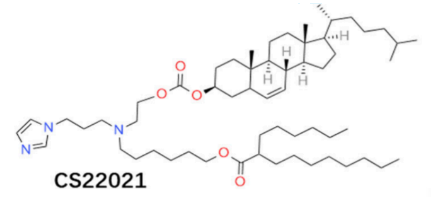
|
| DC67541 | Yoltech lipid 4 |
Yoltech lipid 4, a highly efficient ionizable lipid disclosed in patent PCT/CN2023/116607, features a central tertiary amine group flanked by hydrophobic tails—specifically, a bis(2-ethylhexyl) core and a linoleyl (C18:2) chain linked via ester bonds. This structure enables pH-responsive behavior critical for mRNA/LNP delivery: neutral in circulation (reducing toxicity) but protonated in endosomes to facilitate membrane disruption and payload release. In murine studies targeting liver PCSK9, Compound 4 achieved ~90% gene-editing efficiency. Its optimized formulation yields LNPs of 70–150 nm with >90% encapsulation, ideal for hepatocyte-specific delivery.
More description
|
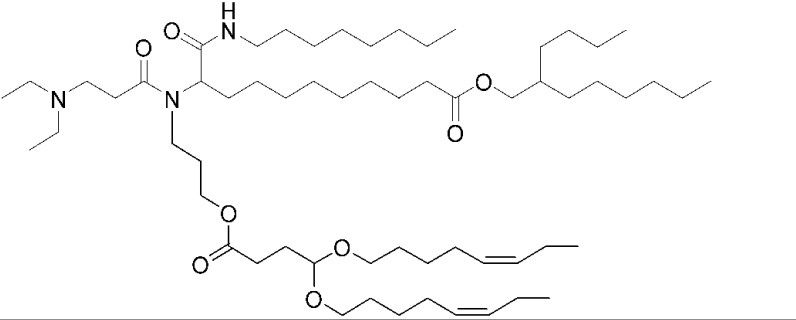
|
| DC67543 | ATX L2 |
L2 is a redox-responsive lipid engineered for ultra-potent siRNA delivery. With shorter hexyl (C6) tails and a carbamate linker, it demonstrates the fastest biodegradation (liver half-life: 2.6 days) among tested lipids. L2 achieves >80% FVII gene knockdown at just 0.01 mg/kg—surpassing both L1 and MC3 in siRNA potency. Its higher apparent pKa (6.90) enhances endosomal disruption, correlating with strong in vitro hEPO expression. While slightly less effective for mRNA than L1, L2’s unmatched siRNA silencing efficiency, rapid cytosolic self-immolation, and low cytotoxicity position it as a leading candidate for RNAi therapeutics targeting hepatic diseases.
More description
|
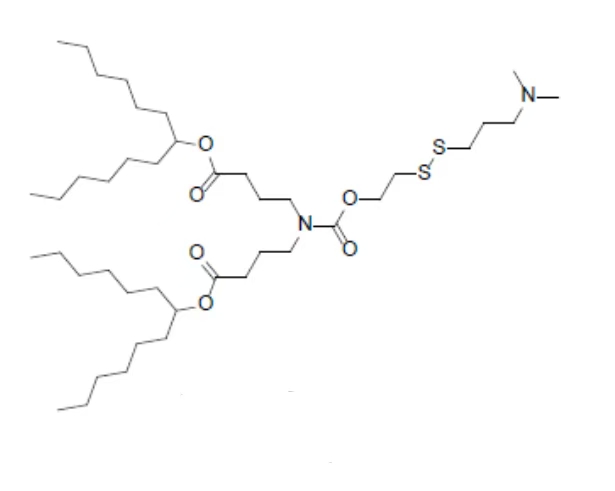
|
| DC60860 | L829 |
L829 is a novel ionizable cationic lipid specifically engineered for targeted lipid nanoparticles (tLNPs) that enables efficient in vivo delivery of mRNA payloads to CD8+ T cells. Designed to overcome limitations of conventional LNPs, L829 significantly reduces off-target delivery to the liver and exhibits rapid clearance compared to benchmark lipids like ALC-0315, while demonstrating enhanced biodegradability and tolerability in rodent and primate models. When incorporated into CD8-targeted tLNPs, L829 enables preferential transfection of CD8+ T cells over other immune subsets, facilitating the generation of functional anti-CD19 or anti-CD20 CAR T cells directly *in vivo*. These tLNP-engineered CAR T cells mediate rapid, deep B-cell depletion in humanized mice and cynomolgus monkeys, with repopulating B cells exhibiting a naïve phenotype suggestive of immune reset. By eliminating the need for ex vivo manufacturing or lymphodepleting chemotherapy, the L829-tLNP platform represents a safer, scalable approach for accessible CAR T therapy in oncology and autoimmune diseases.
More description
|

|
| DC60502 | GalNAc Lipid GL6(GalNAc Lipid 1004) Featured |
GL6 is a trivalent GalNAc-lipid conjugate designed for ASGPR-mediated hepatic delivery. It features a lysine-based scaffold covalently linked to three GalNAc moieties via a 36-unit PEG spacer, anchored by a 1,2-O-dioctadecyl-sn-glyceryl (DSG) lipid tail. This structure balances ligand accessibility (via optimized PEG length) and nanoparticle stability (via hydrophobic DSG anchoring). Compared to GL3 (TRIS scaffold, same PEG length), GL6’s simplified lysine scaffold improves manufacturability. In LDLR-deficient models, GL6 enabled 61% liver editing (vs. 5% with standard LNPs) at 2 mg/kg, demonstrating superior ASGPR targeting. Its design minimizes ligand crowding (0.05 mol% surface density) while maximizing endosomal escape and durable gene editing.
More description
|

|
| DC67551 | Lipid CDL9 |
CDL9 is an original cyclic disulfide lipid first designed, synthesized, and functionally validated in the study "In Vivo Demonstration of Enhanced mRNA Delivery by Cyclic Disulfide-Containing Lipid Nanoparticles for Facilitating Endosomal Escape" published in RSC Medicinal Chemistry (DOI: 10.1039/D5MD00084J).Its molecular architecture—featuring a C18:2 di-unsaturated alkyl chain linked to a tertiary amine headgroup modified with an α-lipoic acid-derived cyclic disulfide unit—was explicitly detailed in the paper's lipid library. Experimental data from this study demonstrated CDL9’s capacity to boost mRNA delivery efficiency by 6-fold in vitro and 5-fold in vivo when integrated into SM102-based LNPs, leveraging thiol-disulfide exchange for enhanced endosomal escape.
More description
|

|
| DC67552 | MeTis Lipid 5 |
MeTis Lipid 5 is an ionizable lipid featuring a pyrazole-based headgroup and biodegradable C8-ester twin tails developed by MeTis Pharmaceuticals (Patent CN118290339B). It demonstrated breakthrough in vivo efficacy (7.08E+10 photons, luciferase assay), surpassing MC3 lipid by 8.8-fold in systemic mRNA delivery. The molecule achieves optimal safety-profile (96.4% cell viability) and encapsulation efficiency (96.4%), forming LNPs of 108.9 nm (PDI 0.17) at N/P 6. Its ester-enabled rapid metabolization and balanced hydrophobicity position lipid 5 as a candidate for next-gen mRNA therapeutics.
More description
|

|
| DC67409 | Galnac Lipid 83 Featured |
Galnac Lipid 83 is developed by Prime Medicine Patent: WO2024220807.Galnac Lipid 83 83 is a GalNAc-conjugated lipid designed for targeted liver delivery. It features a triantennary GalNAc ligand linked via a PEG spacer (e.g., -(CH2CH2O)n-) to a branched hydrophobic tail (C18 alkyl chains). The structure includes amide/ester bonds for stability and a stereospecific configuration (R/S) to optimize ASGPR receptor binding. Integrated into lipid nanoparticles (LNPs), it enhances hepatic uptake of nucleic acids (e.g., mRNA, gene editors) by leveraging ASGPR-mediated endocytosis. Its design balances hydrophilicity (PEG) and lipophilicity (alkyl chains) for efficient encapsulation and in vivo delivery, supporting therapeutic applications in liver-specific gene editing or RNA therapies.
More description
|

|
| DC67554 | MeTis Lipid 1 |
MeTis Lipid 1 is an ionizable lipid featuring a pentacyclic core with geminal dimethyl groups and symmetrical C9 alkyl chains developed by Metis Pharm. According to Patent WO 2025/140421 A1, Lipid 1 demonstrated exceptional biological performance including: the highest SARS-CoV-2 neutralization titer (NT50 1:2146, 5.7-fold higher than ALC0315), potent humoral immunity with COVID-19 IgG titers reaching 1:1,000,000 post-boost and exclusive validation for VZV-gE IgG (1:1,000,000), favorable biophysical properties (124.5 nm LNP diameter, 0.2 PDI, 85% encapsulation efficiency), and excellent safety profile (hERG IC₅₀ >30 μM, Mini-Ames negative), establishing it as the lead compound in nucleic acid vaccine delivery.
More description
|

|
| DC67408 | Galnac Lipid 29 Featured |
Galnac Lipid 29 is from Prime Medicine Patent: WO2024220807. Compound 29 is a GalNAc-functionalized lipid featuring a tripartite structure: an N-acetylgalactosamine (GalNAc) targeting moiety for ASGPR-mediated liver uptake, a flexible PEG-based linker (e.g., ethylene glycol repeats), and dual C18 alkyl chains for lipid nanoparticle (LNP) integration. Its design includes stereospecific amide/urethane bonds (R/S configurations) to optimize stability and ligand orientation. Preclinical data demonstrate enhanced prime editing efficiency (>2-fold vs controls) in hepatocytes at low doses, attributed to improved endosomal escape and payload release. The compound enables liver-specific delivery of CRISPR systems while minimizing off-target accumulation, with <5% activity in non-hepatic cells.
More description
|

|
| DC67557 | Tidal Lipid 40 |
Tidal Lipid 40is an ionizable cationic lipid engineered to deliver RNA with high precision to immune cells like macrophages. Based on Tidal Therapeutics' patent US 20250205169A1, Its pH-responsive design shifts from a +8 mV charge at pH 5.5 (enabling endosomal escape) to near-neutral at pH 7.4 (reducing off -target binding), ensuring efficient intracellular release while maintaining blood stability. In lipid nanoparticles, Lipid 40 achieves 65% transfection efficiency in human macrophages—surpassing benchmarks like ALC-0315—and protects >95% of RNA payloads from degradation. Critically, it maintains particle integrity after freeze-thaw cycles with minimal size drift (<5 nm) and excels in in vivo targeting, driving potent gene expression in tumor-associated macrophages while avoiding liver/spleen accumulation. This combination of precision delivery, stability, and low toxicity makes it ideal for immunotherapies, such as reprogramming M2 macrophages to anti-tumor M1 states.
More description
|

|
| DC67563 | S-Ac7-DOg Featured |
S-Ac7-DOg is an ionizable lipid engineered for optimized mRNA delivery to the retina, featuring a sulfur-based ester bond (S-Ac) and dual oleyl glyceride chains (DOg). Its pKa (~6.74) is finely tuned to enhance endosomal escape in acidic environments, enabling efficient cytosolic mRNA release. Unlike traditional lipids (e.g., C12-200, MC3), S-Ac7-DOg incorporates biodegradable ester linkages that hydrolyze intracellularly, minimizing lipid accumulation and reducing innate immune activation.
In vitro, S-Ac7-DOg LNPs achieved >80% transfection efficiency in retinal cells (ARPE-19, MIO-M1) with negligible cytokine secretion, outperforming MC3 and rivaling C12-200 while avoiding the latter’s high immunogenicity. In vivo, intravitreal delivery in mice showed robust protein expression in the optic nerve head (ONH) and Müller glia (75–100% of eyes), sustained for ≥7 days. Critically, it induced the lowest immunogenicity among tested lipids: minimal leukocyte infiltration (<1.5-fold vs. PBS), no microglial reactivity, and reduced GFAP upregulation.
More description
|

|
| DC67566 | CureVac Lipid C24(CVL1,VitE-C4DE-Pip- S) |
CVL1 (C24) is an ionizable lipid developed by CureVac for mRNA delivery, featuring a vitamin E (α-tocopherol) core linked via a thioether bridge to piperidine-based cationic headgroups. Its unique design enables pH-dependent charge switching (neutral at physiological pH, cationic in endosomes) for efficient mRNA encapsulation and endosomal escape. Formulated in lipid nanoparticles (LNPs) with DPhyPS and PMOZ4, CVL1 preferentially targets spleen and lymph node dendritic cells (DCs), enhancing antigen presentation and T-cell immunity. Key advantages include high mRNA encapsulation (>90%), stability under lyophilization, and reduced liver accumulation compared to PEGylated LNPs. In preclinical studies, CVL1-based LNPs induced robust CD8+/CD4+ T-cell responses and IgG2a-dominant antibody titers against tumor antigens (e.g., Trp2). With a particle size of 70–120 nm and low polydispersity (PDI <0.2), CVL1 balances delivery efficiency and biocompatibility, making it ideal for cancer and infectious disease vaccines requiring strong cellular immunity. Its degradable ester and thioether bonds further improve safety profiles.
More description
|
.png)
|
| DC67570 | Generation Lipid 87 Featured |
Lipid-87 is an ionizable lipid developed by Generation Bio, characterized by its tertiary amine group for pH-dependent protonation and dual C16/C17 aliphatic chains that enhance hydrophobic stability.As the core component (47.5–57.5 mol%) of stealth lipid nanoparticles (LNPs), Lipid87 enables extended blood circulation (>24-hour half-life vs. 30 min for conventional LNPs) by synergizing with steric-stabilizing polymers (e.g., DSG-PEG₂₀₀₀-OMe), achieves >95% encapsulation efficiency for mRNA/ceDNA with low cytotoxicity (IC₅₀ >100 μM), and drives liver-specific targeting (>80% hepatocyte transfection at 0.5 mpk), effectively restoring 40% FIX activity in hemophilia B models for over 7 days.
More description
|

|
| DC49237 | DODAP hydrochloride |
DODAP (hydrochloride) is an ionizable lipid. DODAP (hydrochloride) has the potential for the research of gene delivery.
More description
|

|
| DC60671 | THP1 |
THP1 is a tetrahydropyrimidine ionizable lipid for mRNA delivery. THP1 demonstrates higher transfection efficiency comparable to DLin-MC3-DMA (MC3). THP1 LNPs also demonstrates the ability to edit genes in specific liver tissues in a tdTomato transgenic mouse model.
More description
|
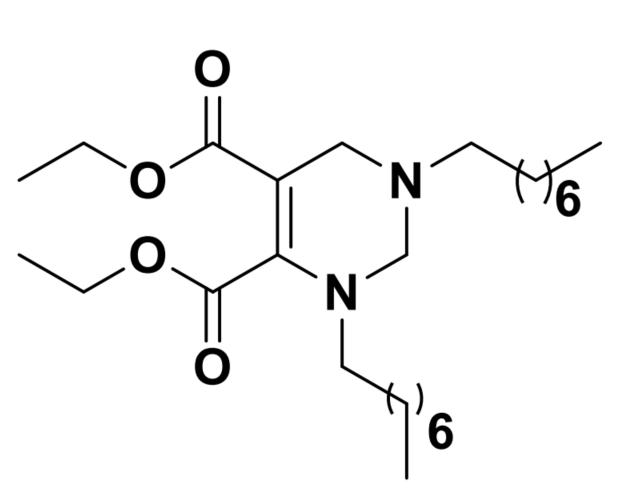
|